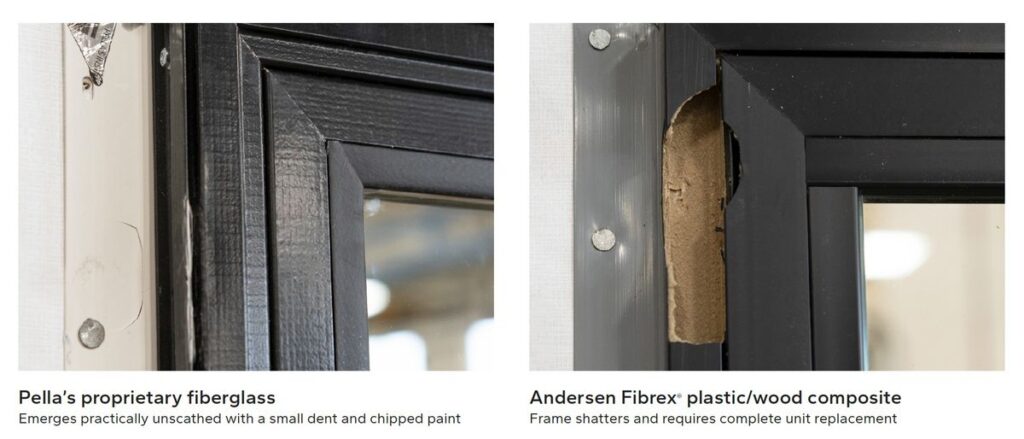The Ultimate Guide: Comparing Impervia and Fibrex

The Ultimate Guide: Comparing Impervia and Fibrex
When it comes to choosing the right materials for your windows, understanding the differences between available options can make a significant impact on your decision. Two popular materials in the market are Impervia and Fibrex. Both offer unique advantages, but which one is the best fit for your home? Let’s dive into the details and explore the key differences between Impervia and Fibrex.
What is Impervia?
Impervia is a proprietary material developed by Pella, which is made from an ultra-durable fiberglass composite. This material is designed to withstand extreme conditions and provide superior performance. Here’s why Impervia stands out:
- Durability: Impervia is known for its exceptional strength and resistance to warping, rotting, and corrosion. It can withstand extreme temperatures, making it ideal for various climates.
- Energy Efficiency: This material offers excellent insulation properties, helping to maintain consistent indoor temperatures and reduce energy costs.
- Low Maintenance: Impervia requires minimal upkeep, thanks to its resistance to fading, chipping, and peeling.
- Aesthetics: With its sleek, modern appearance, Impervia provides a clean look that can complement contemporary architectural styles.
What is Fibrex?
Fibrex is a composite material developed by Renewal by Andersen. It combines reclaimed wood fibers with thermoplastic polymers. This innovative material offers a balance of strength, sustainability, and aesthetics. Here’s why Fibrex is a great choice:
- Environmental Sustainability: Fibrex is made from recycled materials, making it an eco-friendly option for environmentally conscious homeowners.
- Strength and Durability: Fibrex combines the strength of wood with the resilience of plastic, resulting in a robust material that resists decay, warping, and fungal growth.
- Energy Efficiency: Similar to Impervia, Fibrex provides excellent thermal performance, contributing to energy savings and a comfortable living environment.
- Versatility: Fibrex can be molded into various shapes and sizes, allowing for customizable window designs that cater to diverse architectural styles.
Key Differences Between Impervia and Fibrex
- Material Composition:
- Impervia: Made from fiberglass composite, offering superior strength and durability.
- Fibrex: Composed of reclaimed wood fibers and thermoplastic polymers, providing a sustainable and versatile option.
- Biggest Takeaway: Pella’s exclusive fiberglass is the strongest material available for windows and patio doors, engineered for lasting durability.
- Durability:
- Impervia: Highly resistant to extreme weather conditions, making it ideal for harsh climates.
- Fibrex: Strong and resilient, though its performance in extreme conditions may slightly differ from Impervia.
- Biggest Takeaway: Pella’s exclusive fiberglass is on average 10x stronger than Fibrex in a bend test, 100x more impact resistant than Fibrex, and 20x the tensile strength of Fibrex.
- Maintenance:
- Impervia: Low maintenance with resistance to fading, chipping, and peeling. It won’t melt or breakdown when exposed to environmental temperature swings and can handle the most extreme heat and cold.
- Fibrex: Also low maintenance, but may require occasional cleaning to maintain its appearance.
- Biggest Takeaway: Both products are comparable, however, Fibrex may require more maintenance throughout its lifetime.
- Aesthetics:
- Impervia: Offers a modern, sleek look suitable for contemporary homes.
- Fibrex: Versatile in design, allowing for a range of styles from traditional to modern.
- Biggest Takeaway: Both products are comparable.
- Environmental Impact:
- Impervia: Durable and long-lasting and this product line is part of Pella’s most energy-efficient product lines.
- Fibrex: Made from recycled materials, promoting sustainability and environmental responsibility.
- Biggest Takeaway: Impervia meets or exceed ENERGY STAR guidelines in all 50 states and can be used for new construction or window replacement. Pella also offers optional upgrades to further improve efficiency, such as foam-insulated frames and triple-pane glass. Impervia windows also feature Low-E glass, which can reduce glare and heat gain. Pella Impervia products have a 21 percent post-industrial recycled content by weight.
- Affordability:
- Impervia: The price can vary based on the type of window (e.g., double-hung, casement, picture), the size of the window, and any additional features such as special glazing or hardware.
- Fibrex: Similar to Impervia, the cost can depend on the style of the window, the dimensions, and any extra options like custom colors, grille patterns, or energy-efficient glass packages.
- Biggest Takeaway: Impervia is generally more affordable than Fibrex, with average savings around 20-30%.
Which One Should You Choose?
The choice between Impervia and Fibrex ultimately depends on your specific needs and preferences. If you prioritize strength, durability, and low maintenance, Impervia might be the ideal choice for you.
Both materials offer excellent energy efficiency and performance, ensuring that your windows not only look great but also contribute to a comfortable and cost-effective home.
Final Thoughts
Choosing the right material for your windows is a crucial decision that can impact the longevity, performance, and aesthetics of your home. By understanding the differences between Impervia and Fibrex, you can make an informed choice that aligns with your specific needs and values.
For more information on window materials and to explore your options, feel free to contact us or visit our showroom. Our experts are here to help you find the perfect windows for your home!
Getting new doors is exciting, but there’s a lot to know! Get in touch with Pella Windows and Doors of Dallas/Fort Worth today and learn more about how a new front door can improve your home and the quality of your life.
